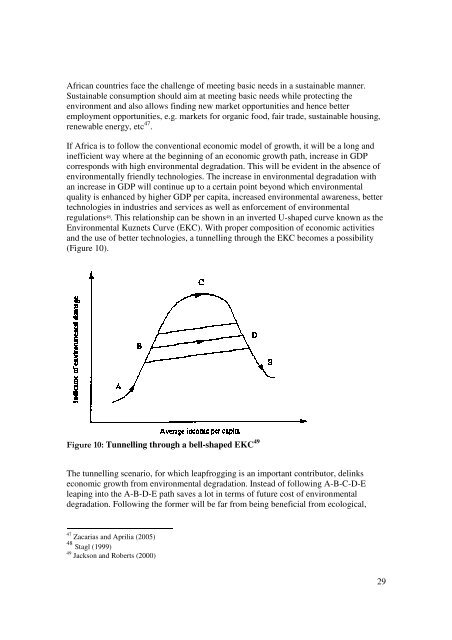Leapfrogging Possibilities For Sustainable Consumption and ...
Leapfrogging Possibilities For Sustainable Consumption and ...
Leapfrogging Possibilities For Sustainable Consumption and ...
Create successful ePaper yourself
Turn your PDF publications into a flip-book with our unique Google optimized e-Paper software.
African countries face the challenge of meeting basic needs in a sustainable manner.<br />
<strong>Sustainable</strong> consumption should aim at meeting basic needs while protecting the<br />
environment <strong>and</strong> also allows finding new market opportunities <strong>and</strong> hence better<br />
employment opportunities, e.g. markets for organic food, fair trade, sustainable housing,<br />
renewable energy, etc 47 .<br />
If Africa is to follow the conventional economic model of growth, it will be a long <strong>and</strong><br />
inefficient way where at the beginning of an economic growth path, increase in GDP<br />
corresponds with high environmental degradation. This will be evident in the absence of<br />
environmentally friendly technologies. The increase in environmental degradation with<br />
an increase in GDP will continue up to a certain point beyond which environmental<br />
quality is enhanced by higher GDP per capita, increased environmental awareness, better<br />
technologies in industries <strong>and</strong> services as well as enforcement of environmental<br />
regulations 48 . This relationship can be shown in an inverted U-shaped curve known as the<br />
Environmental Kuznets Curve (EKC). With proper composition of economic activities<br />
<strong>and</strong> the use of better technologies, a tunnelling through the EKC becomes a possibility<br />
(Figure 10).<br />
Figure 10: Tunnelling through a bell-shaped EKC 49<br />
The tunnelling scenario, for which leapfrogging is an important contributor, delinks<br />
economic growth from environmental degradation. Instead of following A-B-C-D-E<br />
leaping into the A-B-D-E path saves a lot in terms of future cost of environmental<br />
degradation. Following the former will be far from being beneficial from ecological,<br />
47 Zacarias <strong>and</strong> Aprilia (2005)<br />
48 Stagl (1999)<br />
49 Jackson <strong>and</strong> Roberts (2000)<br />
29
















